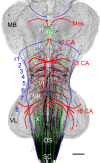Hindbrain neurovascular anatomy of adult goldfish (Carassius auratus)
- PMID: 31218682
- PMCID: PMC6742896
- DOI: 10.1111/joa.13026
Hindbrain neurovascular anatomy of adult goldfish (Carassius auratus)
Abstract
The goldfish hindbrain develops from a segmented (rhombomeric) neuroepithelial scaffold, similar to other vertebrates. Motor, reticular and other neuronal groups develop in specific segmental locations within this rhombomeric framework. Teleosts are unique in possessing a segmental series of unpaired, midline central arteries that extend from the basilar artery and penetrate the pial midline of each hindbrain rhombomere (r). This study demonstrates that the rhombencephalic arterial supply of the brainstem forms in relation to the neural segments they supply. Midline central arteries penetrate the pial floor plate and branch within the neuroepithelium near the ventricular surface to form vascular trees that extend back towards the pial surface. This intramural branching pattern has not been described in any other vertebrate, with blood flow in a ventriculo-pial direction, vastly different than the pial-ventricular blood flow observed in most other vertebrates. Each central arterial stem penetrates the pial midline and ascends through the floor plate, giving off short transverse paramedian branches that extend a short distance into the adjoining basal plate to supply ventromedial areas of the brainstem, including direct supply of reticulospinal neurons. Robust r3 and r8 central arteries are significantly larger and form a more interconnected network than any of the remaining hindbrain vascular stems. The r3 arterial stem has extensive vascular branching, including specific vessels that supply the cerebellum, trigeminal motor nucleus located in r2/3 and facial motoneurons found in r6/7. Results suggest that some blood vessels may be predetermined to supply specific neuronal populations, even traveling outside of their original neurovascular territories in order to supply migrated neurons.
Keywords: brainstem; central arteries; cerebral vessels; motor nuclei; neuroepithelium; reticulospinal neurons; rhombomere; teleost.
© 2019 Anatomical Society.
Figures









Similar articles
-
A hindbrain segmental scaffold specifying neuronal location in the adult goldfish, Carassius auratus.J Comp Neurol. 2014 Jul 1;522(10):2446-64. doi: 10.1002/cne.23544. J Comp Neurol. 2014. PMID: 24452830
-
Segmental development of reticulospinal and branchiomotor neurons in lamprey: insights into the evolution of the vertebrate hindbrain.Development. 2004 Mar;131(5):983-95. doi: 10.1242/dev.00986. Development. 2004. PMID: 14973269
-
Segmental arrangement of reticulospinal neurons in the goldfish hindbrain.J Comp Neurol. 1993 Mar 22;329(4):539-56. doi: 10.1002/cne.903290409. J Comp Neurol. 1993. PMID: 8454739
-
[Functional organization of escape circuits built in teleost hindbrain segments].Nihon Shinkei Seishin Yakurigaku Zasshi. 2008 Jun;28(3):127-30. Nihon Shinkei Seishin Yakurigaku Zasshi. 2008. PMID: 18646598 Review. Japanese.
-
Segmental Analysis of the Vestibular Nerve and the Efferents of the Vestibular Complex.Anat Rec (Hoboken). 2019 Mar;302(3):472-484. doi: 10.1002/ar.23828. Epub 2018 May 7. Anat Rec (Hoboken). 2019. PMID: 29698581 Review.
Cited by
-
Composition of encephalic arteries and origin of the basilar artery are different between vertebrates.Surg Radiol Anat. 2024 Mar;46(3):285-297. doi: 10.1007/s00276-023-03286-6. Epub 2024 Mar 13. Surg Radiol Anat. 2024. PMID: 38478075
-
Developmental neuroanatomy of the rosy bitterling Rhodeus ocellatus (Teleostei: Cypriniformes)-A microCT study.J Comp Neurol. 2022 Aug;530(12):2132-2153. doi: 10.1002/cne.25324. Epub 2022 Apr 25. J Comp Neurol. 2022. PMID: 35470436 Free PMC article.
References
-
- Allen W (1905) . The blood-vascular system of the Loricati, the mail-cheeked fishes. Proc Washington Acad Sci 7,27‐157
-
- Allis E (1912) The pseudobranchial and carotid arteries in Esox, Salmo and Gadus, together with a description of the arteries of the adult Amia. Anat Anz 41, 113–141.
-
- Anadón R, Molist P, Rodríguez‐Moldes I, et al. (2000) Distribution of choline acetyltransferase immunoreactivity in the brain of an elasmobranch, the lesser spotted dogfish (Scyliorhinus canicula). J Comp Neurol 420, 139–170. - PubMed
-
- Brantley RK, Bass AH (1988) Cholinergic neurons in the brain of a teleost fish (Porichthys notatus) located with an antibody to choline acetyltransferase. J Comp Neurol 275, 87–105. - PubMed
Publication types
MeSH terms
Grants and funding
LinkOut - more resources
Full Text Sources

